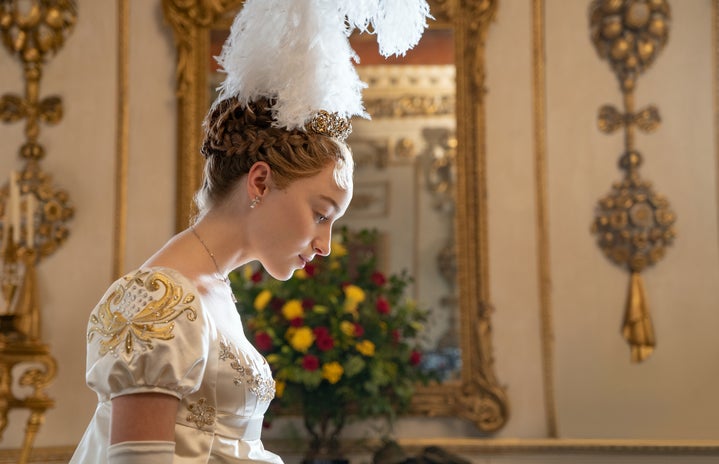This past week, I hit a major life milestone. Sorry, I mean a major fashion life milestone: I purchased my first corset top. After about two months of seeing the same corset top from Urban Outfitters show up on my TikTok for you page time and time again with rave reviews, I caved. In my defense, I have been trying not to buy clothes just because of trends and have been fairly successful at it. The last time I caved into a trend and bought something was a year ago when someone posted a sloth pillow pet, and that was a necessary purchase that I still have. Her name is Sonny, and she lives rent-free in my head.
Anyways, it was long overdue for me to be irresponsible, stupid, and spend an obscene amount of money on a tank top. I’ve always been afraid of corsets, just because I am not an extra small with a tiny waist and long legs. I thought that it wouldn’t look good on me, but after the sixth or seventh TikTok that made me compare myself, I decided to purchase the corset to prove to myself that it would look pretty on me as well.
Guess what? It does! I love it, it makes me feel confident and beautiful and was worth every cent. If you have been looking at something online but haven’t purchased it yet because you are afraid of how it will look on you, do it. It may not seem like it because all models on most retail websites are skinny, perfect, and size zero, but clothing is for everyone and anyone.
Since I purchased the corset, I’ve been thinking about why I like it so much. Maybe it’s because I also watched Bridgeton season two, but the article of clothing has lived in my mind. Out of curiosity, I decided to start doing some research on the history of the corset as an article of clothing, and the result is my first Her Campus article! I am constantly fascinated by fashion trends and how they come in and out of style, and I’m so excited to write more pieces about pop culture and style in the future. In the meantime, enjoy my hours of research, and after this, I highly recommend you watch Bridgeton season two if you love a good enemies-to-lovers storyline. Now, let’s delve into a brief history lesson on this controversial article of clothing.
16th and 17th Centuries
- Introduced by Catherine de Medici into France in the 1500s, where the women of the French loved the vibes. This type of corset was a tight, elongated bodice that was worn underneath the clothing. The women of the French court saw this corset as “indispensable to the beauty of the female figure.” (we love an hourglass moment)
- By the middle of the sixteenth century, corsets were a commonly worn garment among European and British women! It helped them look snatched asf under their dresses.
- The garments gradually began to incorporate the use of a “busk,” a long, flat piece of whalebone or wood sewn into a casing on the corset to maintain its stiff shape. The front of the corset was typically covered by a “stomacher,” a stiff, V-shaped structure that was worn on the abdomen for decorative purposes.
18th and 19th CENTURIES
- The most common type of corset in the 1700s was an “inverted conical shape”, which is much simpler terms was worn to create a contrast between a rigid, tight torso above the waist and heavy full skirts below.
- The primary purpose of 18th-century stays was to raise and shape the breasts, squeeze the midriff, support the back, improve posture to help a woman stand straight, with the shoulders down and back, and only slightly narrow the waist, creating a ‘V-shaped upper torso. I have horrible posture, so maybe my corset can help?
- Both garments were considered undergarments and would be seen only under very limited circumstances. Well-fitting eighteenth-century corsets were quite comfortable, did not restrict breathing, and allowed women to work, although they did restrict bending at the waist. The thought of wearing a corset to class or work kind of makes me want to cry- but to each their own I guess…
- By 1800, the corset had become primarily a method of supporting the breasts, as the waist was raised to just under the bust line. Corsets still slimmed the torso, but this was not their primary purpose anymore. We love a snatched moment.
Transition to victorian corsets
- When the waistline returned to its natural position during the 1830s, the corset make another reappearance in culture and served the dual purpose of supporting the breasts and narrowing the waist. However, it had changed its shape to the hourglass silhouette that is even now considered typical both for corsets and for Victorian fashion. At the same time, the term corset was first used for this garment in English.
- In 1839, a Frenchman by the name of Jean Werly made a patent for women’s corsets made on the loom. This type of corset was popular until 1890 when machine-made corsets gained popularity. Before this, all corsets were handmade.
THE VICTORIAN CORSET
- When the exaggerated shoulders disappeared, the waist itself had to be cinched tighter to achieve the same effect. The focus of the fashionable silhouette of the mid-and late 19th century was an hourglass figure with a tiny waist. It is in the 1840s and 1850s that tightlacing first became popular. Usually, corsets at this time were a two-man job- one to wear, and one to tie and squeeze lol.
- The corset differed from the earlier stays in numerous ways. The corset no longer ended at the hips, but flared out and ended several inches below the waist. The corset was exaggeratedly curvaceous rather than funnel-shaped- finally. Women are not shaped like funnels so IDK why this change took so long. While many corsets were still sewn by hand to the wearer’s measurements, there was also a thriving market for cheaper mass-produced corsets.
Late 19th Century
- In the late 19th century concern about reports of tight-lacing caused a movement for rational dress. Some doctors were found to support the theory that corsetry was injurious to health (particularly during pregnancy). In reality, tight corseting was most likely the cause of indigestion and constipation but rarely the cause for a plethora of ailments associated with tight corseting at the time.
- In part as a response to the perceived dangers of tight-lacing, but also due to women’s increasing interest in outdoor activities, “health corsets” became popular during the late 19th century.
- In 1884, A German physician came up with wool sanitary corsets, described as flexible and elastic. They were also durable and responded to movements. Another was created in 1887, a dermatitis corset with leather facing. It was marketed toward women who wanted better health and enjoyed a vigorous lifestyle. You could not PAY ME to work out in a corset. Nope.
AFTER WORLD WAR ONE
- Shortly after the United States entered into World War I in 1917, the U.S. War Industries Board asked women to stop buying corsets to free up metal for war production. This fact made me laugh out loud, I cannot believe that much metal was needed to make women’s clothing.
- This step liberated some 28,000 tons of metal, enough to build two battleships. (again, I’m dead lol) The corset, which had been made using steel stays since the 1860s, ost popularity as women took to brassieres and girdles which also used less steel in their construction.
- After World War I, changes in the economy also changed women’s roles in society. In the early 20th century, a young woman would typically have started wearing a corset at about 15 years old, and live at home until she married around age 18. After the war, more young women sought an education, and in the Western world, marriage was delayed until they reached their middle to late 20s.
THE CORSET AND POP CULTURE
- In the 1970s, Vivienne Westwood began using corsets as part of her punk aesthetic; imagining her corset designs to empower women rather than bind them. As she should!! What an icon.
- Jean-Paul Gaultier and Thierry Mugler incorporated corsets into their designs in the 1980s, and who can forget Madonna making Gaultier’s pink satin corset famous during her 1990 Blond Ambition tour?
- Since then, Stella McCartney, Yves Saint Laurent, Tom Ford, and Nicolas Ghesquière at Balenciaga have all experimented with corsets or corset-like tailoring in their designs, sometimes layering corsetry over garments rather than under them, moving the piece from underwear to outerwear.
- Always holding court in fashion photography, too, corsets have evolved from patriarchal into a symbol of free female sexuality, arguably coming full circle by being depicted in modern period dramas that center on the characters of women, such as Bridgerton and The Great. Like all good things, they had an arduous journey to get there.
- Around March 2022, Urban Outfitters released the “Out From Under Modern Love Corset” which BLEW UP on TikTok and is now constantly sold out. What’s next for the corset? Who knows. For now, it’s become a staple in every college girl’s closet.
—————
Sources: Vogue, Champagne Corsets, Mina Le on Youtube, Fine Arts Museum of San Fransisco, Instyle


